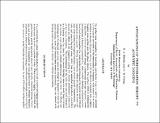| dc.contributor.author | Ellefsen, K. J. | |
| dc.contributor.author | Cheng, C. H. | |
| dc.contributor.other | Massachusetts Institute of Technology. Earth Resources Laboratory | en_US |
| dc.date.accessioned | 2012-11-29T20:26:38Z | |
| dc.date.available | 2012-11-29T20:26:38Z | |
| dc.date.issued | 1989 | |
| dc.identifier.uri | http://hdl.handle.net/1721.1/75111 | |
| dc.description.abstract | For guided wave propagation in boreholes, perturbation theory is used to calculate
(1) the partial derivative of the wavenumber or frequency with respect to an elastic
modulus or density, (2) group velocity, and (3) the effect of a borehole with a slightly
irregular cross section upon the phase velocity. The method, which is developed for
a fluid-filled, cylindrical borehole through a transversely isotropic formation, relates
perturbations in formation properties (i.e., elastic moduli, densities, and interface locations) and wave properties (i.e., wavenumber and frequency) for guided waves with any
azimuthal order number. Velocity perturbations, which are calculated for three common
cross sections of irregular boreholes, show several general characteristics. The
tube and pseudo-Rayleigh waves, which have no azimuthal dependence, completely
smooth the effects of the irregularity making the velocity perturbation independent
of the wave's orientation. The perturbations for the tube wave are small because it
is a Stoneley wave, but those for the pseudo-Rayleigh wave are much larger because
the borehole shape affects the multiply-reflected part of this wave. The velocity perturbations for the flexural and screw waves are similar in character to those for the
pseudo-Rayleigh wave, but because these waves are directional, they can interact with
the irregularity to amplify or diminish the velocity perturbation. | en_US |
| dc.description.sponsorship | Massachusetts Institute of Technology. Full Waveform Acoustic Logging Consortium | en_US |
| dc.description.sponsorship | Phillips Petroleum Fellowship | en_US |
| dc.publisher | Massachusetts Institute of Technology. Earth Resources Laboratory | en_US |
| dc.relation.ispartofseries | Earth Resources Laboratory Industry Consortia Annual Report;1989-02 | |
| dc.title | Applications Of Perturbation Theory To Acoustic Logging | en_US |
| dc.type | Technical Report | en_US |
| dc.contributor.mitauthor | Ellefsen, K. J. | |
| dc.contributor.mitauthor | Cheng, C. H. | |
| dspace.orderedauthors | Ellefsen, K. J.; Cheng, C. H. | en_US |
